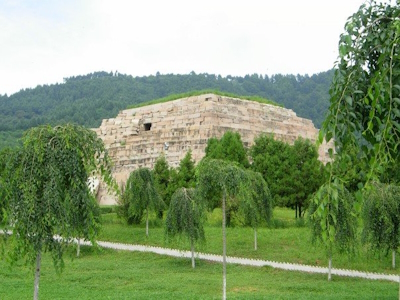Koguryo Kingdom

The Capital Cities and Tombs of the Ancient Koguryo Kingdom represent an exceptional testimony to the vanished Koguryo civilization.
These archaeological sites comprise their first three capitals and 40 tombs. The imperial tombs have a stepped pyramid form, while the tombs of the nobles are decorated with wall paintings that depict scenes from daily life. Stele and inscriptions at the sites show the impact of Chinese culture on the Koguryo.
Community Perspective: Zoë liked Wandu Mountain City best and has written an overview of what you can see on a 3-hour visit.
Map of Koguryo Kingdom
Load mapCommunity Reviews
Zoë Sheng
Chinese-Canadian - 13-Mar-19 -

Koguryo Kingdom covers the sites on the Chinese side of the border. There is a separate, identical inscription for the DPRK which will probably never merge.
I visited this place a couple of years ago in winter. Not the best place to visit in winter but it was a lovely sunny day. My main plan was to continue north to Harbin for the ice festival so it "had" to be winter.
Arriving by train I rented a taxi for the day. The driver knew all locations well. You buy a ticket for 4 attractions although I don't remember getting checked for the tombs and the mountain city, maybe the driver just let someone know I have a ticket while I was away. The first one is the Haotai Stele where a guide was explaining the stele with another group of tourists. It is inside a building with large glass windows. It was built in AD 414 and describes the founding of the Koguryo Kingdom. There is a lot of information about the stele online I don't wish to repeat, but looking into it is certainly an interesting and long (very long) read.
Next stop is the Jiangjunfen Tomb and surrounded by several of the general's subordinates. There is not much to see but walk around the square structure. Impressive tomb nonetheless, sometimes referred to as the Pyramid of the East for good reason. Here I was also stopped by what I'm quite are fake policemen pretending to look for illegal immigrants - as if they would be hanging around at the tombs...(tip: don't show anyone your passport or ID if they don't wear a proper uniform).
Third stop is the Nobelmen's Cemetery at Yushan. The tomb have some neat wall paintings inside as well and are thus only opened when visitors arrive. You need the guide to use the flashlight anyway.
Last and probably best of all four is the Wandu Mountain city, now in ruins, but the location of the city surrounded by steep mountains is ingenious, with the nearby valley providing enough expansion and farm land to feed the city. I really like it. There are also walls (newly built?) going up along both sides of the mountain. I climbed up the right side almost all the way to the top for an amazing view. The snow made it a little difficult but totally worth it (besides, it doesn't feel like real snow if you have spent a winter in Canada!). I took a breather at the top, obviously took a lot more pics, it makes you think how they picked this nice place for a city and what happened to it. Going down is tougher in the snow.
The taxi driver then wondered why I took so long and didn't just "look around a little" and demanded another 100RMB...any excuse to demand extra cash but that doesn't fly with me. Back to the train station for the originally negotiated price it was. Including my hike I spent maybe 3h in total for all sites.
tian
I have been to this WHS in 2008. Koguryo kindom was not an empire since its kings were always authorised by Chinese emperors. The most visitable place is Ji'an, Jilin province. Besides of some ancient ruins, you can see a big stele "Haotaiwangbei", which is famous for its Chinese calligraphy. Wukuifen is an ancient tomb with many mural showing how ancient Chinese understand the universe, the Chinese legendary emperor Fuxi and Shennong was pictured on the wall.
Community Rating
Site Info
- Full Name
- Capital Cities and Tombs of the Ancient Koguryo Kingdom
- Unesco ID
- 1135
- Country
- China
- Inscribed
- 2004
- Type
- Cultural
- Criteria
-
1 2 3 4 5
- Categories
- Archaeological site - Far Eastern
- Link
- By ID
Site History
2004 Inscribed
Site Links
Unesco Website
Related
Connections
The site has 20 connections
Art and Architecture
Constructions
Damaged
Geography
History
Human Activity
Individual People
Religion and Belief
Timeline
Trivia
World Heritage Process
Visitors
37 Community Members have visited.
The Plaque
No plaque has been identified yet for this site.